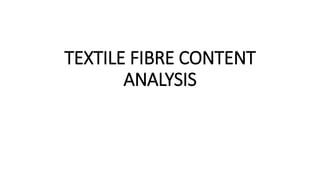
Fibre content analysis.pptx
- 2. FIBRE CONTENT/COMPOSITION Analysis of fibre content: 1) Qualitative analysis 2) Quantitative analysis (for blended material) Qualitative analysis 1. By Flame/burn test 2. By solubility test
- 3. Blended yarn : It is the kind of yarn in which several types of fibers are mixed together. They exhibit a blended characteristic which is entirely new. Mainly, two or more constituents are blended together to get the product. Blended fabric: It is created when two or more different kinds of fibres are mixed together to create a new fabric with unique properties. ... Polyester and cotton, which combines the properties of natural and synthetic fibres, is one of the most common blended fabrics. Some common blends in textiles: • Polyester/Cotton. (PC, TC or CVC) • Nylon/Wool. • Nylon/Acetate. • Ramie/Polyester. • Ramie/Acrylic. • Wool/Cotton. • Linen/Cotton. • Linen/Silk. *PC or TC= blends of polyester and cotton (amount of polyester>amount of cotton in blend) *CVC (chief value of cotton)= blends of polyester and cotton (amount of cotton>amount of polyester blend)
- 4. BLEND RATIO/BLEND PERCENTAGE OF TEXTILES Amount (on the basis of weight) of different fibres mixed together in a blend. Example: • 80/20 PC means a blend of polyester and cotton where the amount of polyester is 80% and cotton is 20% of the total weight of the blend. • 80/20 CVC means a blend of polyester and cotton where the amount of cotton is 80% and polyester is 20% of the total weight of the blend. *80/20 pc and 80/20 cvc is just opposite to each other according to percentage of each component
- 5. Quantitative analysis of different fibres in common blend: A blend contains two fibres: i. A and ii. B Let, Percentage amount of ‘A’ fibre in the blend=PA Percentage amount of ‘B’ fibre in the blend=PB Total dry weight or initial weight of the material= x Oven-Dry weight of fibre ‘B’ (after dissolving ‘A’) = yB So, PB= 𝑦𝐵 𝑥 𝑋 100 % PA= (𝑥−𝑦) 𝑥 X 100% or, PA= 100-PB NB: *YA +YB = X * PA + PB =100 * Oven-dry weight/dry weight": The constant weight of textile material obtained by drying at a temperature of 105 Oc.
- 6. Textile Fibres Solvent Concentration.(%) Temp(oC) Time(min) Cotton Sulfuric acid 70 38 20 Polyester m-cresol 100 139 5 Wool Sodium hypochlorite 5 20 20 Acrylic Dimethyl formamide (DMF) 100 90 10 Nylon Formic Acid 85-90 20 5 Hydrochloric acid 20 20 10 Silk Sodium hypochlorite 5 20 20 Sulfuric acid 60 38 20 Acetate Acetic acid 100 20 5 Spandex Dimethyl formamide (DMF) 100 90 10 Viscose Sulfuric acid 60 38 20
- 7. Practice math: 1. A 25 gm sample of Cotton and acrylic blended sample was treated in a solution of 70% sulphuric acid. After dissolving the cotton part, the residual dry mass acrylic was found to be 5 gm. Find the blend ratio or blend percentage of each content in the blend. (Ans: cotton/acrylic: 80/20) 2. A sample of 60/40 p/c blended fabric gives an oven dry weight of 15 gm after dissolving with 70% sulphuric acid. Find i) the total weight of the sample and ii) other fibre weight in the blend. (Ans: 25 gm, 10 gm) 3. A sample of 75/25 CVC blended fabric gives an oven dry weight of 23 gm after dissolving with m-cresol. Find i) the total weight of the sample and ii) other content weight in the blend with name. (Ans: 30.66 gm, 7.66 gm (polyester)) 4. A sample of T/C blended fabric shows 20 gm in electric balance. Find out the oven dry weight of residual fibre after dissolving with m-cresol. Given that percentage of cotton in the blend is 30%. (Ans: 6 gm)
- 8. 5. A solvent of Sulphuric acid (59.5%) is used at 20oC for 20 min to separate a blend of Cotton/silk sample. After dissolving one of them the dried solid mass gives 10 gm. The cellulosic content of the blend shows a value of 45% in the blend. Find out the original weight of the content which was dissolved in 59.5% acid. (Ans: 8.18 gm) 6. A sample of blended fabric contains an animal fibre and a manmade fibre and shows 15 gm in electric balance. i) Find out the oven dry weight of animal fibre after dissolving with Dimethyl formamide. Given that percentage of manmade fibre in the blend is 30% and the animal fibre can be dissolved in Sodium Hypochlorite. ii) Identify the two fibres. (Ans: 10.5 gm, manmade fibre: Acrylic, animal fibre: wool/ silk) 7. A sample of blended fabric shows 25gm in electric balance contains two fibres ‘a’ and ‘b’. A solvent of Sulphuric acid (59.5%) or 5% Sodium hypochlorite is used at 20oC for 20 min to separate them by dissolving ‘a’. If the ‘a’ fibre content of the blend shows a value of 45% in the blend, i) find out the original weight of the other content which could be dissolved in 100% meta- cresol. ii) Find out the name of fibres too. (Ans: i) 13.75 gm ii) Polyester and silk )
- 9. 8. An Acrylic/wool blended fabric shows an oven dry weight of 0.05 ounce after treating with 5% Sodium hypochlorite solution at room temperature. If the protein fibre content was 40% in the blend, then find the initial weight of fabric sample taken. (Ans: .083 ounce) 9. A sample of Nylon/Viscose blended fabric weighed as 1.0 gm. Find out the oven dry weight of sample after dissolving with Formic acid. Given that percentage of Nylon in the blend is 85%. [Ans: 0.15 gm] …………..x……........